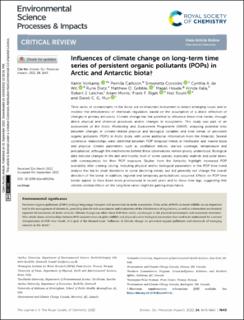| dc.contributor.author | Vorkamp, Katrin | |
| dc.contributor.author | Carlsson, Pernilla Marianne | |
| dc.contributor.author | Corsolini, Simonetta | |
| dc.contributor.author | de Wit, Cynthia A. | |
| dc.contributor.author | Dietz, Rune | |
| dc.contributor.author | Gribble, Matthew O. | |
| dc.contributor.author | Houde, Magali | |
| dc.contributor.author | Kalia, Vrinda | |
| dc.contributor.author | Letcher, Robert J. | |
| dc.contributor.author | Morris, Adam | |
| dc.contributor.author | Rigét, Frank F. | |
| dc.contributor.author | Routti, Heli Anna Irmeli | |
| dc.contributor.author | Muir, Derek C.G. | |
| dc.date.accessioned | 2022-10-25T05:48:53Z | |
| dc.date.available | 2022-10-25T05:48:53Z | |
| dc.date.created | 2022-10-19T15:17:56Z | |
| dc.date.issued | 2022 | |
| dc.identifier.citation | Environmental Science: Processes & Impacts. 2022, 24 (10), 1643-1660. | en_US |
| dc.identifier.issn | 2050-7887 | |
| dc.identifier.uri | https://hdl.handle.net/11250/3028061 | |
| dc.description.abstract | Time series of contaminants in the Arctic are an important instrument to detect emerging issues and to monitor the effectiveness of chemicals regulation, based on the assumption of a direct reflection of changes in primary emissions. Climate change has the potential to influence these time trends, through direct physical and chemical processes and/or changes in ecosystems. This study was part of an assessment of the Arctic Monitoring and Assessment Programme (AMAP), analysing potential links between changes in climate-related physical and biological variables and time trends of persistent organic pollutants (POPs) in Arctic biota, with some additional information from the Antarctic. Several correlative relationships were identified between POP temporal trends in freshwater and marine biota and physical climate parameters such as oscillation indices, sea-ice coverage, temperature and precipitation, although the mechanisms behind these observations remain poorly understood. Biological data indicate changes in the diet and trophic level of some species, especially seabirds and polar bears, with consequences for their POP exposure. Studies from the Antarctic highlight increased POP availability after iceberg calving. Including physical and/or biological parameters in the POP time trend analysis has led to small deviations in some declining trends, but did generally not change the overall direction of the trend. In addition, regional and temporary perturbations occurred. Effects on POP time trends appear to have been more pronounced in recent years and to show time lags, suggesting that climate-related effects on the long time series might be gaining importance. | en_US |
| dc.language.iso | eng | en_US |
| dc.publisher | Royal Society of Chemistry | en_US |
| dc.rights | Navngivelse-Ikkekommersiell 4.0 Internasjonal | * |
| dc.rights.uri | http://creativecommons.org/licenses/by-nc/4.0/deed.no | * |
| dc.title | Influences of climate change on long-term time series of persistent organic pollutants (POPs) in Arctic and Antarctic biota | en_US |
| dc.type | Peer reviewed | en_US |
| dc.type | Journal article | en_US |
| dc.description.version | publishedVersion | en_US |
| dc.rights.holder | This journal is © The Royal Society of Chemistry 2022 | en_US |
| dc.source.pagenumber | 1643-1660 | en_US |
| dc.source.volume | 24 | en_US |
| dc.source.journal | Environmental Science: Processes & Impacts | en_US |
| dc.source.issue | 10 | en_US |
| dc.identifier.doi | 10.1039/d2em00134a | |
| dc.identifier.cristin | 2062907 | |
| cristin.ispublished | true | |
| cristin.fulltext | original | |
| cristin.qualitycode | 1 | |

